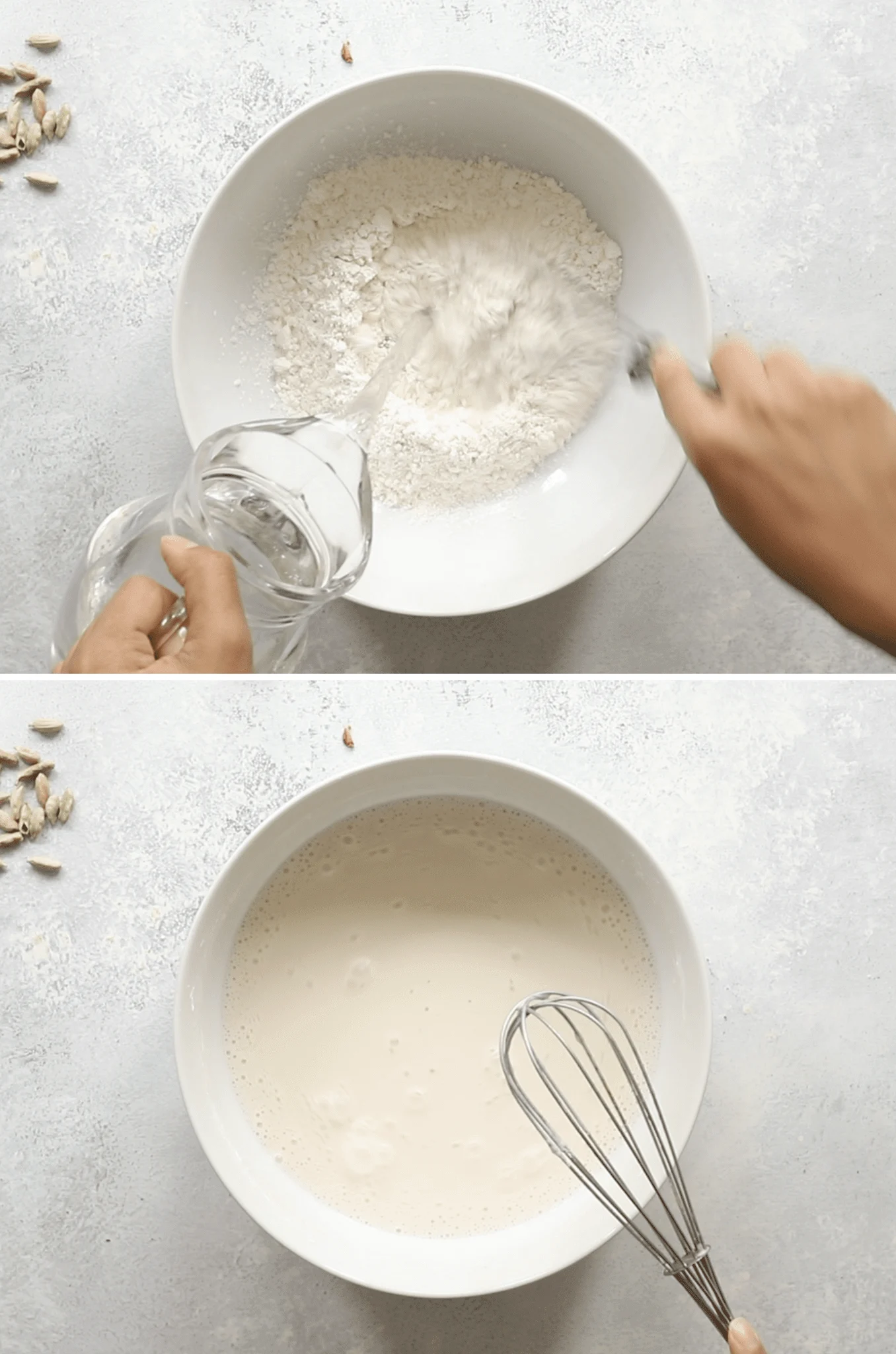Malindi Halwa – Lozi (Kenyan Almond Halwa) will forever be my first love when it comes to mithai (sweets).
A jelly-like almond halwa with the sweet aromas of rose, saffron and cardamom.
All you need are a handful of ingredients and lots of stirring!Unwrapping a brown paper-clad log of Malindi Halwa has always been a momentous joy for me.
Although tightly bound, the rosy aromas still permeated through the paper cover.
Tearing one side of the paper would feel like I was playing the children’s party game, pass the parcel.
I’d remove only as much paper to suit the portion I’d like to eat, take a deep inhale and revel in the deeply comforting floral smell of this jewel-toned sweet.
The translucent halwa was glossy with ghee and a carrier for the copious amounts of whole almonds, after which it is named.
Where does Malindi Halwa – Lozi (Kenyan Almond Halwa) come from?

Malindi is Kenya’s second largest coastal town and is at the centre of a strip of idyllic tropical beaches.
Traditionally a port city, located on Kenya’s east coast, Malindi was for centuries a colonial trading post.
The food of this region has therefore been influenced by multiple cultures, from Arabic and Indian, to Portuguese and British.
Why is it called Lozi?
The name Lozi refers to almonds and has roots in the Persian language لوز (lowz, luz), since this style of halwa was most likely introduced by the muslim community of Kenya.
In Swahili, almonds are typically called Lozi or Mlozi. Malindi Halwa Lozi (Kenyan Almond Halwa) is similar to Omani Halwa.
Memories of Malindi Halwa
Malindi Halwa Lozi (Kenyan Almond Halwa) is difficult to come by in the UK, unless you make it yourself.
Growing up in a Yorkshire town meant that I often missed comfort foods like these.
I have the fondest memories of visiting my kaka (uncle) in the more cosmopolitan city of Watford, just outside of London.
He would always make sure he bought a log of Malindi Halwa from the local shop when I came to visit.
What are the main ingredients in Malindi Halwa?


The base ingredients of this Kenyan almond halwa are tapioca (cassava) starch, sugar, ghee, whole blanched almonds (skinless almonds) and water.
Rose water, saffron, cardamom and red/orange food colour are secondary ingredients.
Ground nutmeg is also a popular addition to this East African style of halwa.
Where to buy tapioca starch
You can source tapioca starch quite inexpensively at most African, South Asian, Chinese or South American food stores. It may also be labelled ‘cassava starch’ or ‘yuca starch’.
Note that it must be tapicoa/cassava starch and not flour as these are two different byproducts of the same root. They are not interchangeable.
Tapioca starch is also available to buy online, along with all the other ingredients you need to make this Halwa recipe.
This post contains Amazon Affiliate links. These are all products I have purchased of my own accord and ones that I use myself. None of the products mentioned have been gifted to me. By using an affiliate link, I receive a small commission at no expense to you. This commission helps to support this blog. Thanks in advance if you choose to make a purchase through these links!
How to make Malindi Halwa – Lozi (Kenyan Almond Halwa): Step-by-step instructions
Time needed: 1 hour and 20 minutes
Try this Malindi Halwa Lozi (Kenyan Almond Halwa) recipe with step-by-step photos and video. Learn how to make delicious halwa with easy instructions. Full recipe card below.
- Whisk tapioca starch with cold water
Add water a little at a time to ensure the mixture is not lumpy. Be sure to use very cold water. Rest the mixture for 30 minutes.

- Melt the ghee, add flavourings and food colour
Heat the ghee until fully melted and warm. Don’t overheat the ghee. Add the rosewater, saffron, ground cardamom and food colour. Set aside.

- Melt the sugar with water
Use a large, non-stick, heavy-based pan. Mix together the sugar and water until the sugar melts.
- Combine the tapioca starch mixture with the sugar mixture
As soon as the sugar mixture comes to the boil, add the tapioca starch mixture. Stir continuously over a medium heat until thick, glossy and pasty.

- Begin to add ghee
Add the ghee a ladleful at a time, stirring until fully combined between each addition. Stir the whole time. The halwa will bubble and thicken considerably. After about 35 minutes of cooking, it will form a ball that comes away from the sides of the pan.
- Add almonds
Throw in your whole, blanched almonds and stir to combine. Cool for 5-10 minutes.
- Roll
Place a very large piece of cling film on a worktop and put the halwa on top. Roll into a tight log, as per the video tutorial. Wrap in newspaper or brown paper and allow to set at room temperature for 2-3 hours before serving. Alternatively, place the halwa on a greased metal plate, cool and serve by the spoonful.

How to blanch almonds

lace whole, raw almonds in a bowl. Cover with boiling water and allow to stand for 20 minutes.
Once the water has cooled, gently press the almonds to slip them out of their skins.
Malindi Halwa – Lozi (Kenyan Almond Halwa) recipe
Malindi Halwa Lozi (Kenyan Almond Halwa)

My first mithai love. Tapioca starch halwa studded with almonds and scented with rose, saffron and cardamom. This Kenyan-style halwa is traditionally wrapped in paper and sold by the log. Warm it up for a delicious, stretchy, jelly-like halwa. It's so fun to eat!
Ingredients
- 125 g tapioca starch
- 500 ml cold water
- 350 g white sugar
- 400 ml cold water
- 125 g ghee
- Small pinch of saffron
- 2 tsp rosewater
- 8 cardamom pods seeds ground
- 50 g blanched almonds see video for how to blanch almonds
- Orange and red food colours
Instructions
- Place tapioca starch in a large bowl. Gradually add 500ml cold water and whisk until you have a smooth, flowing mixture. Set aside for 30 minutes.
- Melt the ghee in a pan. Add saffron, rosewater, ground cardamom seeds and food colours.
- Place the sugar in a large, heavy-based non-stick pan. Add 400ml water, switch the heat on and stir until the sugar dissolves. Whisk the tapioca starch mixture once more. Once the sugar mixture comes to a boil, pour in the tapioca starch mixture.
- Cook over a medium-low heat, stirring all the time. The mixture will begin to thicken and turn translucent in some parts. Keep stirring and cooking.
- After about 10 minutes it will thicken into a glossy paste. It'll look a bit like gloopy wallpaper paste. Once it reaches this stage, add a ladleful of the warm ghee mixture and stir well. Continue to stir and cook, adding the ghee mixture in small increments every 2-3 minutes, until all of it is used up.
- The mixture will begin to bubble up in places and thicken significantly. It will turn from pasty, to jelly-like as you cook. The whole process will take about 30 minutes. Towards the end of the cooking time, the halwa mixture will form an elastic, slow-moving goo-like consistency! It should look shiny and translucent. The colour should be a deep orange-red tone. Add more food colour if you need to. Once the halwa pulls away from the sides of the pan in a mass like this, it's ready. Watch my video tutorial to see all the stages and consistency you're looking for.
- Add the blanched almonds and stir to embed the almonds into the halwa. Allow to cool for 5 minutes and then place the halwa on a very large piece of cling film.
- Shape the still-elastic halwa into a thick log, about 20-25cm wide. Use gloves if you find it still too hot to touch. Tightly wrap the halwa in the cling film. Scrunch the ends up to form a Christmas cracker shape and twist to tighten. Now wrap the log in newspaper or brown paper. Allow to cool completely at room temperature and serve. You can refrigerate this halwa log for up to a month.
- You can also turn the halwa out onto a greased tray and flatten slightly. Cut into pieces and serve warm or at room temperature.
Notes
This Malindi Halwa will keep well in the fridge (wrapped) for 1 month. Do not freeze. To re-heat the halwa, place a slice on a plate and microwave for 15 seconds. It'll heat up really quickly so keep an eye on it and make sure it's cooled down a little before you eat it.
Nutrition Information:
Yield: 10 Serving Size: 1 gramsAmount Per Serving: Calories: 328Total Fat: 15gSaturated Fat: 8gTrans Fat: 0gUnsaturated Fat: 6gCholesterol: 32mgSodium: 30mgCarbohydrates: 49gFiber: 1gSugar: 37gProtein: 1g
Pin this Malindi Halwa – Lozi (Kenyan Almond Halwa) recipe for later!

If you like this, you’ll love my recipe for Perfect Vegan Jalebi



Coconut Mogo (Cassava in Coconut Milk) - East African Dishes
Thursday 28th of March 2024
[…] can even turn it into sweet Halwa! This Malindi Halwa is a popular Kenyan dessert with […]
Perfect Seeroh (Sooji Halwa) - Sanjana.Feasts - Indian Sweets + VIDEO
Friday 18th of August 2023
[…] Malindi Halwa […]
Chand
Sunday 23rd of May 2021
Very good recipe. Reminded me of kenya, always used to eat this delicious halwo